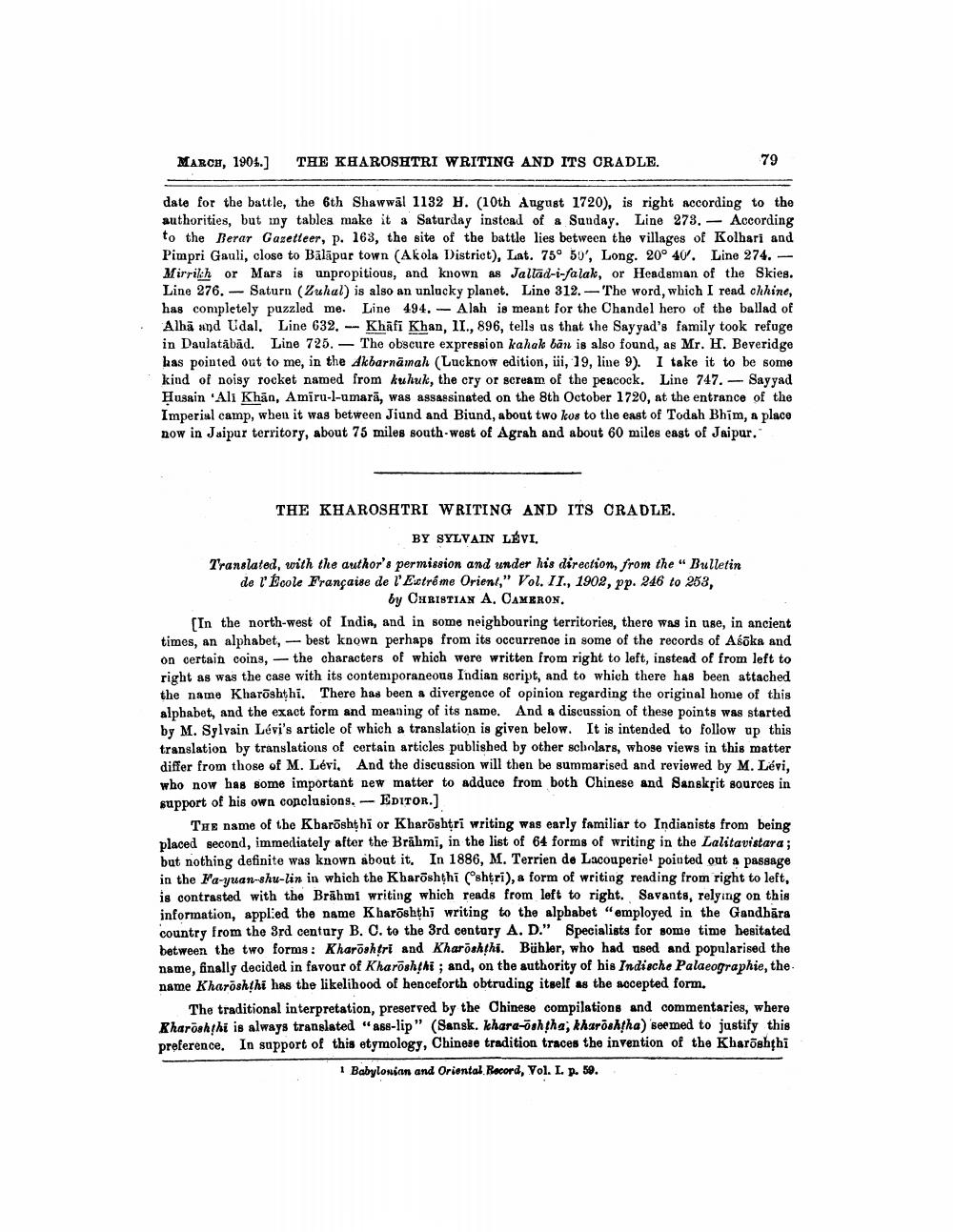________________
MARCH, 1904.]
THE KHAROSHTRI WRITING AND ITS CRADLE.
79
date for the battle, the 6th Shawwāl 1132 H. (10th Angust 1720), is right according to the authorities, but my tables make it a Saturday instead of a Sunday. Line 273. — According to the Berar Gazetteer, p. 163, the site of the battle lies between the villages of Kolhari and Pimpri Gauli, close to Bālāpur town (Akola District), Lat. 75° 50', Long. 20° 40'. Line 274. - Mirrikh or Mars is unpropitious, and known as Jaltad-i-falak, or Headsman of the Skies. Line 276. - Saturn (Zuhal) is also an unlucky planet. Line 312.-The word, which I read chhine, has completely puzzled me. Line 494, - Alah is meant for the Chandel hero of the ballad of Alhā and Udal. Line 632. -- Khāfi Khan, II., 896, tells us that the Sayyad's family took refuge in Daulatābād. Line 725. - The obscure expression kahak ban is also found, as Mr. H. Beveridge has pointed out to me, in the Akbarnämah (Lucknow edition, iii, 19, line 9). I take it to be some kind of noisy rocket named from kuhuk, the cry or scream of the peacock, Line 747. - Sayyad Husain Ali Khan, Amiru-l-umarā, was assassinated on the 8th October 1720, at the entrance of the Imperial camp, when it was between Jiund and Biund, about two kos to the east of Todah Bhim, a place now in Jaipur territory, about 75 miles south-west of Agrah and about 60 miles east of Jaipur."
THE KHAROSATRI WRITING AND ITS CRADLE.
BY SYLVAIN LÉVI. Translated, with the author's permission and under his direction, from the “ Bulletin de l' Boole Française de l'Esctreme Orient," Vol. II., 1902, pp. 246 to 253,
by CHRISTIAN A. CAMERON. In the north-west of India, and in some neighbouring territories, there was in use, in ancient times, an alphabet, -- best known perhaps from its occurrenoe in some of the records of Asöka and on certain coins, the characters of which were written from right to left, instead of from left to right as was the case with its contemporaneous Indian script, and to which there has been attached the name Kharoshthi. There has been a divergence of opinion regarding the original home of this alphabet, and the exact form and meaning of its name. And a discussion of these points was started by M. Sylvain Lévi's article of which a translation is given below. It is intended to follow up this translation by translations of certain articles published by other scholars, whose views in this matter differ from those of M. Lévi. And the discussion will then be summarised and reviewed by M. Lévi, who now has some important new matter to adduce from both Chinese and Sanskrit sources in support of his own conclusions. - EDITOR.]
The name of the Kbarosht hi or Kharöshtri writing was early familiar to Indianists from being placed second, immediately after the Brāhmi, in the list of 64 forms of writing in the Lalitavistara; but nothing definite was known about it. In 1886, M. Terrien de Lacouperiel pointed out a passage in the l'a-yuan-shu-lin in which the Kharoshthi (shtri), a form of writing reading from right to left, is contrasted with the Brāhmi writing which reads from left to right. Savants, relying on this information, applied the name Kharõskthi writing to the alphabet "employed in the Gandbāra country from the 3rd century B. C. to the 3rd century A. D." Specialists for some time hesitated between the two forms: Kharöshtri and Kharoshthi. Bühler, who had used and popularised the name, finally decided in favour of Kharoshthi ; and, on the authority of his Indische Palaeographie, the name Kharoshthi has the likelihood of henceforth obtruding itself as the socepted form.
The traditional interpretation, preserved by the Chinese compilations and commentaries, where Rharoshthi is always translated "888-lip" (Sansk. khara-Ōshtha, kharoshtha) seemed to justify this preference. In support of this etymology, Chinese tradition traces the invention of the Kharoshthi
1 Babylonian and Oriental Record, Vol. I. p. 59.




